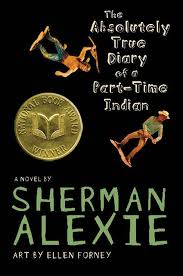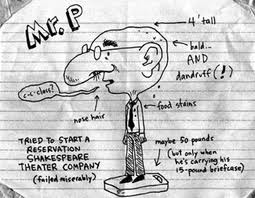The Absolutely True Diary of a Part-Time Indian
By Sherman Alexie and art by Ellen Forney
Disclaimer: this novel contains sexual content and language possibly offensive to some readers. Please check with your parents before reading.
The Story: Arnold Spirit, nicknamed Junior, lives on the Spokane Indian Reservation, and he is really excited about starting high school, especially his first geometry class. When his geometry teacher, Mr. P, hands out their textbooks, Junior’s has a name scribbled on the first page: Agnes Adams. Junior’s mother’s name. Which means the textbook is at least thirty years old. The one light in Junior’s life is diminished as he realizes no one really cares about his education, and he feels trapped. In a rage he throws the text book and hits Mr. Pit in the face, breaking the teacher’s nose. Instead of being mad, Mr. P apologizes to Junior: “You were right to throw that book at me. I deserved to get smashed in the face for what I’ve one to Indians,” but Mr. P adds: “All the Indians should get smashed in the face too . . . The only thing you kids are being taught is how to give up . . . All these kids have given up. All your friends. All your bullies. And their mothers and fathers have given up, too. And their grandparents gave up and their grandparents before them. And me and every other teacher here. We’re all defeated” (42). Mr. P sees promise in Junior because he hasn’t yet given up, so he urges him to leave the rez school and transfer to Reardan high school, for a better education.
The novel follows Junior’s difficult journey of transferring to a new school. Junior battles feelings of guilt that he has betrayed his tribe, and the loneliness from feeling invisible in the white-washed halls of Reardan high school. Junior must learn how to navigate staying connected to his family and community, while also integrating himself into a new community at Reardan.
What Wallace and I Think: This is my third time reading Absolutely True Diary, which is funny because one character, Gordy, says you have to read any book three times to get the most out of it. However, after finishing my third reading, I know there is much more to gleam from even more rereading’s, and I’m sure this isn’t the last time I’ll come to it. My future students can expect to see this on many a syllabus.
The Absolutely True Dairy started out as Alexie Sherman’s autobiography, but publishers encouraged him to pursue it as his first YA work, because so much of it was focusing on his childhood. As a result, Junior shares many commonalities with his creator. Like Junior, Alexie was born with “water on the brain” and barely survived his infancy, but didn’t have all the lasting side-effects that Junior does, like his stutter and lisp. Like Junior, Alexie also found his mother’s name in his geometry text book, but when he angrily threw the book it thankfully hit a wall and not a teacher. And like Junior, Alexie transferred to Reardan high school, but did so because he had already decided to go to college, and needed extra credits that were only offered in Reardan.
In literary studies, we have the habit of questioning when the narrator tells the reader they are telling the truth. Because Junior declares this story is absolutely true, I have been trained to automatically be suspicious, and consider him an unreliable narrator. It’s the whole, the lady doth protest too much, thing. If the narrator IS telling the truth, why does he have to tell us he’s telling the truth? Does that mean anything else he said, and didn’t indicate as being true, was a lie? Literary scholars are a distrusting bunch. But asking these sorts of questions helps to investigate meaning in the narratives, and learn more about the narrators. So while many of the stories are true, the title begs the reader to question (or so an English major would argue), is it an absolutely true diary? Looking at the similarities and differences between Junior and Alexie, finding what is absolutely true, is one place to investigate the meaning in the gaps between truth and fiction.
Junior has a dark sense of humour that literally had me laughing while crying several times. On my third reading. So I knew what was coming, and I still was crying while laughing. Junior strikes a fine balance of healthy pessimism with a dash of optimism. Meaning, he sees people and things for what they truly are, but he doesn’t lose hope that he can overcome the obstacles before him. Much of what Junior says is meant to make readers feel uncomfortable, whether they come from a background similar to his, or that of the kids at Reardan. No one gets a free pass. It aims to challenge readers’ thinking and perceptions.
A special feature of the novel is Ellen Forney’s illustrations. Junior is a cartoonist. He is always drawing because “I feel like it might be my only real chance to escape the reservation. I think the world is a series of broken dams and floods, and my cartoons are tiny little lifeboats” (6). Forney does an amazing job of creating art for the book from the perspective of Junior. She includes doodles from his notebooks, cartoons and caricatures of himself, his family and friends that are brutally honest, and more realistic sketches that are a loving way to honour those close to him. Junior’s illustrations add depth to an already profound novel. Forney does so well at echoing the dark humour Alexie gives to Junior, giving it new form through the illustrations.
The Absolutely True Diary is an important book to read because of its dark humour and its ability to challenge readers’ thinking and make you uncomfortable, because this may change your thinking and actions in the real world. Young adults, as well as adults should be reading this book. Really, we should be reading anything by Sherman Alexie, because he is a gift.
I give Alexie’s novel a 5/5

